Menus
- BMW F 800 GT against Honda CBF 1000 and Suzuki GSX 650 F
- MOTORCYCLE scoring / test result
- Technical specifications
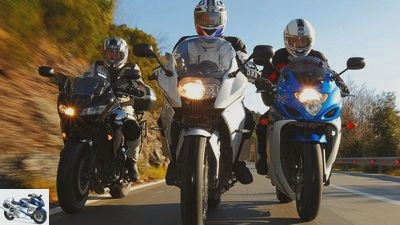
Bilski
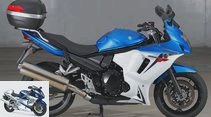
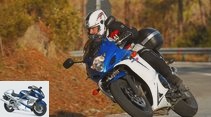
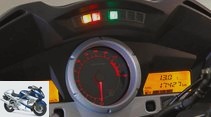

18th photos
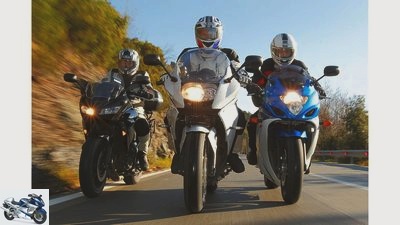
Bilski
1/18
The three all-rounders: Honda CBF 100 F, BMW F 800 GT and Suzuki GSX 650 F in a comparison test.
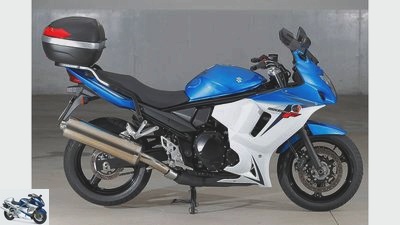
Bilski
2/18
Sporty appearance with overweight. When driving, the GSX 650 F impresses with its solid handling.
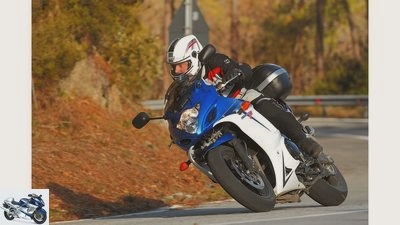
Bilski
3/18
Suzuki GSX 650 F.

Bilski
4/18
A pleasant command center that could easily provide more information.

Bilski
5/18
The spring preload of the fork is adjustable as with the BMW and the Suzuki.
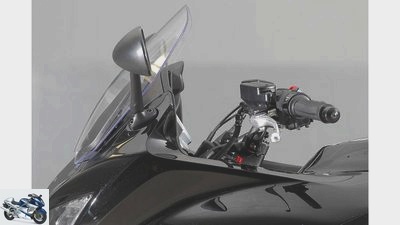
Bilski
6/18
The windshield can be adjusted four times by hand.
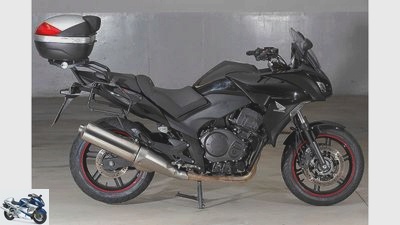
Bilski
7/18
At 244 kg, the CBF is not particularly light, but it is surprisingly easy to drive.
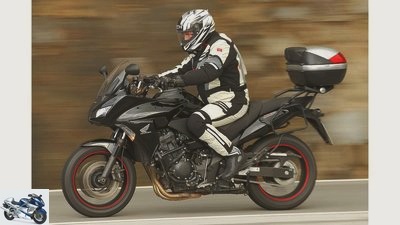
Bilski
8/18
Honda CBF 1000.
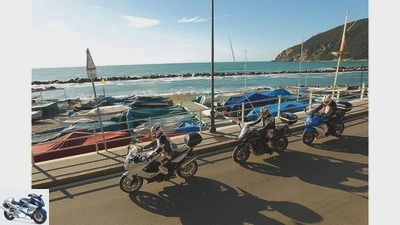
Bilski
9/18
On the western Mediterranean coast of Italy, winter can be easily survived on a two-wheeler.
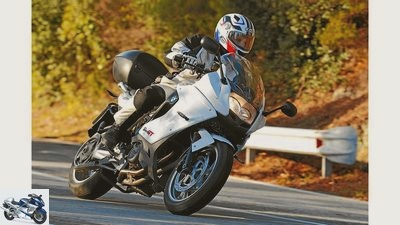
Bilski
10/18
BMW F 800 GT.
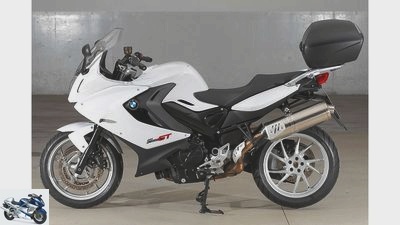
Bilski
11/18
Looks cool and drives like that. The rear wheel rim of the GT comes into its own.
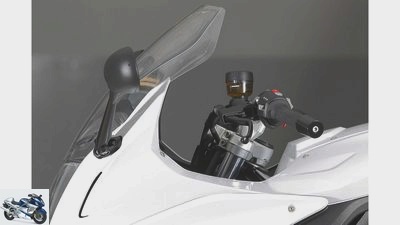
Bilski
12/18
New, higher and wider windshield. Unfortunately not adjustable.
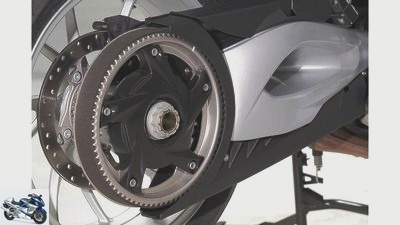
Bilski
13/18
The belt has remained, the swing arm has been redesigned and is 50 mm longer.
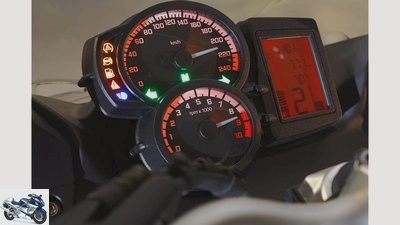
Bilski
14/18
Classic analog instruments with digital LCD on-board computer.
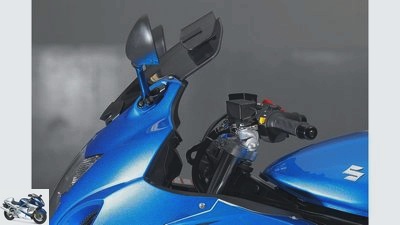
Bilski
15/18
The optional windshield can be individually adjusted.
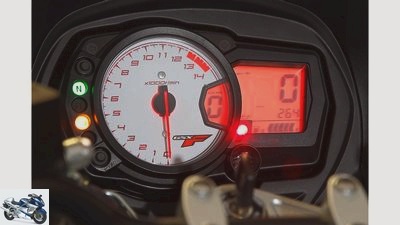
Bilski
16/18
This is chic! The gear indicator makes sense, the shift light less.
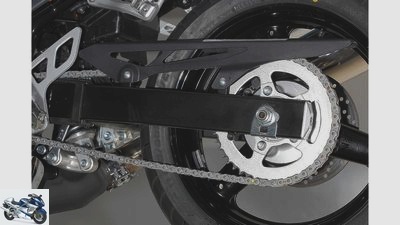
Bilski
17/18
The simple box swing arm made of steel unfortunately looks pretty cheap.
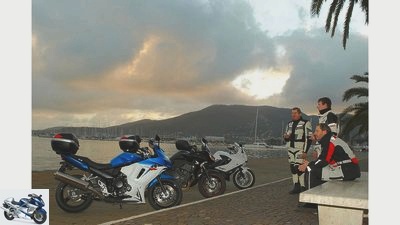
Bilski
18/18
The Honda CBF 1000 F – the motorcycle for all occasions – wins the group test.
The all-rounders from BMW, Honda and Suzuki in a comparison test
BMW F 800 GT against Honda CBF 1000 and Suzuki GSX 650 F
Mid-range all-rounders not only offer beginners good driving dynamics and reasonable comfort on long journeys – reason enough that two tried-and-tested representatives of the class compete with the new BMW F 800 GT in a comparison test.
Three mid-range all-rounders are available for testing in Italian regions. They court their potential customers with a wide range of uses without wanting to tear an exorbitantly large hole in their wallets. The fact that the middle class now has something in store for all tastes is of course good news. But the upcoming purchase of the latest piece of jewelry is a difficult matter. If you can do without first place in the ice cream parlor rating and take part in economic activity in a more utility-oriented manner, you essentially have to answer two questions: How much displacement does it really have to be – are the 656 cubic centimeters of a Suzuki GSX 650 F sufficient or should the 998 be enough the Honda CBF 1000 F? Are you a fan of the mature Japanese four-cylinder or would you rather have a refreshed, distinctive Munich parallel twin of the BMW F 800 GT with 798 cubic meters in the garage?
Here on the western Mediterranean coast of Italy, somewhere between Genoa and La Spezia, the decision is just as difficult as at home in the Harz Mountains. Here, beyond the engine specifications, glaring differences emerge on the plain sheet of paper. The Suzuki immediately attracts attention here. Not only does it remain by far the cheapest bike in the test field with a cost price below the 8,000 euro mark, but you also get the most motorcycle for it – at least in terms of weight. With a full tank of nearly five hundred pounds (247 kilograms) she is quite overweight. The modular principle of the Suzuki Bandit and GSX F series – the 1250 and 650 models largely share the same chassis – certainly saves costs, but results in superfluous pounds for the smaller-displacement variants. The fact that the Honda, which is available for just under 11,000 euros, is even less than the weight of the Suzuki despite its considerably larger engine, weighs 244 kilograms.
D.The model boy mimes the new BMW F 800 GT in this category. Tester Jelicic looks downright puzzled when he places the Bavarian on the optionally available main stand with unimaginable ease. Aha, 221 kilos can feel that light! And while we’re at the motorcycles, we prefer to put the notes aside and let the actors speak for themselves.
Buy complete article
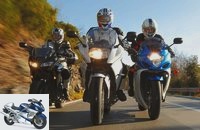
The all-rounders from BMW, Honda and Suzuki in a comparison test
BMW F 800 GT against Honda CBF 1000 and Suzuki GSX 650 F
Bilski
Suzuki GSX 650 F.
Another praise follows. The seat height of the CBF can be adjusted in three stages using the standard bench. Without any tools (780 mm, 795 mm, 810 mm). The seat height of the BMW can also be adjusted, but you have to swap the whole seat for either the extra comfort seat (820 mm) or the very low cushion (765 mm). By default, the F 800 beds its driver at a height of 80 centimeters, which is good for most drivers, at least in terms of overall ergonomics. Because if you expected a real tourer at the GT, you will notice at the latest when you sit down that the spirit of a cheeky highway robber is hidden here. Sporty bent legs meet a fairly straight upper body. The new, vibration-decoupled handlebar is mounted higher than its predecessor and is slightly angled towards the driver. In contrast to the other two bikes, you tend to sit on the motorcycle instead of in it. However, this is not necessarily a point of criticism. Because despite the redesigned, now somewhat more generous cladding, the BMW has retained its rather narrow silhouette, which harmonizes wonderfully with the seating position. It’s a bit like cycling. In a positive sense.
Speaking of driving, we’re doing that now too. All engines start when the outside temperature is eight degrees after a short push of the button and take on the gas without delay. The two four-cylinders sound restrained, the GT-Twin attracts more attention acoustically thanks to the exhaust system adopted from the F 800 R. That sounds robust, but by no means rowdy. Will the three all-rounders drive as the seating position and styling suggest? Up it goes on the initially still wet roads of the Cinque Terre National Park. If the Japanese roll up the first fog-shrouded pass on narrow 160 rear tires, the BMW is equipped with a thick, not exactly handling-promoting 180 tire, which is the only one in the test field to be driven via a large belt. Practical because it saves you buying chain sets and the stylish rear wheel rim is always free of grease. The Suzuki, which has just been reprimanded, also appears fat-free, it skilfully conceals its pounds while driving. You can move around completely relaxed, navigate light-footed through narrow downhill passages. Only when you are faster with the Suzi do her pounds become more significant and have to be brought more energetically than with the other two. The engine of this test copy runs smoothly and doesn’t vibrate as much as the last copy that was used for a mid-range comparison (see MOTORRAD 14/2012). The four-cylinder is virtually idle without bothering about it, and almost 40 km / h in sixth gear is no challenge, but only as long as it goes leisurely. If the two opponents ahead are serious, you have to diligently step up and down again through the gearbox with long shift travel and only passable detent in order to stay tuned. It goes without saying that the measured 81 PS with the weight and small displacement will eventually have a negative impact on the 650. The chassis remains pretty unimpressed by the brisk pace, is overall balanced, but quite tightly dampened. The fork will stuck a little if you cross joints in quick succession. Acoustically, the GSX spoils the driver at high speeds with a very Suzuki-typical, great turbine sound that does not sound screeching at all. That pleases the athlete’s heart.
Bilski
Honda CBF 1000.
It is only logical that the Honda, with its larger combustion chambers, strikes a much richer tone. The four-cylinder, with a peak of 110 hp, is an ideally designed drive for everyday use. Smooth, high-torque at the bottom, at the same time unexcited and yet greedy for speed: This is exactly how a motor should punch. Thanks to its great pulling power, the CBF even manages tight bends in third gear, where the Suzuki wants to be moved at least in second gear, and the BMW even in first gear due to a long gear ratio and a higher basic speed level.
The 1000 is a fantastic soul flatterer, you can travel with it so carefree – and also whiz along the house route. Where the other two drivers not only work diligently with the gearbox, but also have to put a lot of physical effort into cornering, the Honda is still incredibly relaxed on the road. The precise chassis in combination with the finely damped spring elements works wonderfully. The balance between comfort and sporty and firm is perfectly implemented. Load changes and responsiveness are also flawless and even better than the little Japanese. Because of its upbeat, not quite as smooth-running two-cylinder, the BMW can hardly keep up.
The fat pounding boxer – oh pardon! Paralleltwin – the Bavarian pushes ahead briskly from around 3000 revolutions, becomes a tad more energetic from around 5000 revolutions. With a view of the 94 hp peak power and a powerful 88 Newton meters, one expects that the Suzuki can clearly distance it in terms of performance and, because of the lower weight, possibly even come close to the Honda. But the disillusionment follows quickly: In the draft section, it cannot outpace the weakest in displacement due to its far too long gear ratio, between 100 and 140 km / h even the GSX F is ahead, the Honda has long been over the mountains. In general, BMW has to work hard not to lose touch with the CBF. The handling of the Gran Tourismo is okay, but it suffers from the wide rear tires and the longest wheelbase in the test. In return, the Bavarian is always full on the asphalt, always allowing the driver to circle the corners with great precision and in a stable direction. So anything but bad, just not as light-footed as the 1000s. On the damping side, the BMW does not show any nakedness, convinces with a good mixture of sporty, firm and comfortable. Thanks to the ESA, the rear rebound can be adjusted accordingly from the handlebars, which is at least done manually with the two competitors. Ultimately, the gearshift of the BMW is not really inspiring, the gears lock into place exactly, but want to be changed vigorously. If you are too indecisive with your left foot, the frictional connection between the desired gear pairing will not be established. Then there is a strong rumble in the transmission.
Bilski
BMW F 800 GT.
And which motorcycle now offers the widest range of uses? The clarification of this question over an espresso at the port of La Spezia is open to discussion, because each test candidate offers his own answer. If the weight of the GSX F suffers from the generously dimensioned chassis of the 1250-Bandit, then with 208 kilograms you can saddle it up the most. In addition, the full fairing offers great wind and weather protection, which is only topped by the BMW. The Suzuki is certainly not an exciting motorcycle, but like its brakes it leaves a completely solid impression, which is only tarnished by the rather high gasoline consumption for this displacement.
Because although the BMW has a whole 15 liter reserve canister of petrol less than the Suzuki, it stops just 30 kilometers earlier in the range chapter thanks to its economical engine. The new cladding and the higher windshield of the GT have been noticeably optimized compared to its predecessor. The good wind protection of the legs and feet is particularly noticeable. However, their ergonomics are still too sporty for an all-rounder. Those who like to be faster on the road are well served with the new F 800 GT. The faster you rush through the run with it, the more comfortable you feel on it. Only the brake metering with a pressure point that is not crystal clear tarnishes this picture a bit, whereas the delay is otherwise convincing. And the Honda? It justifiably wins the comparison, as it combines the varied demands of everyday cyclists in the best possible way. With its great engine, the finely balanced chassis and – for this cubic capacity – acceptable thirst for gasoline, you never feel out of place with it. However, if you often travel with a pillion passenger, you should consider the rather meager payload of 196 kilograms. Otherwise, it offers everything you would expect from a great all-rounder. And that too at a fair price.
MOTORCYCLE scoring / test result
engine
You can’t win more clearly. The Honda inspires with its powerful four-cylinder in every speed range. This is matched by the exact gearshift and the appropriate gear ratio, which is suitable for everyday use. The BMW loses here mainly due to the poor performance as a result of the overly long chosen overall ratio. The Suzuki is doing bravely despite the displacement disadvantage.
Winner engine: Honda
landing gear
The driving stability of the BMW is excellent, but the handling of the Honda and Suzuki is better. Unfortunately, the CBF touches down on the asphalt relatively early, which costs important points. The competitors have significantly more reserves. Although the suspension elements of the GSX 650 F are well and tightly damped, the suspension comfort is only sufficient.
Chassis winner: BMW
everyday life
The Suzuki is allowed to shoulder the most luggage. The Honda fails here, and the BMW is only allowed to load just under 200 kilograms. The Bavarian test machine is equipped with numerous features such as electronically adjustable rebound stage damping for the shock absorber, traction control and heated grips. If the CBF scores with the most relaxed seating position, it is left behind in the chapter on wind protection.
Winner everyday life: BMW
security
The brakes of the Japanese have a clear pressure point and decelerate very evenly with increasing brake pressure. The F 800 GT reduces the risk of handlebar bumps with a tight steering damper.
Safety winner: BMW
costs
Great fuel consumption figures and an inspection only every 10,000 kilometers: this is where the BMW comes up.
Winner costs: BMW
Price-performance
The GSX 650 F offers a very solid performance for its low cost price.
Price-performance winner: Suzuki
| Max. score | BMW | Honda | Suzuki | Overall rating | 1000 | 668 | 672 | 621 | placement | 2. | 1. | 3. | Price-performance note | 1.0 | 1.7 | 1.6 | 1.5 |
Bilski
The Honda CBF 1000 F – the motorcycle for all occasions – wins the group test.
MOTORCYCLE test results
1. Honda CBF 1000 F
The motorcycle for every eventuality: The Honda impresses across the board with the widest range of uses. First class is above all the powerful four-cylinder, the great ergonomics and the great chassis.
2.BMW F 800 GT
With its low weight, reassuring driving stability and a precise chassis, the BMW is a clear recommendation for the more sporty, committed driver.
3. Suzuki GSX 650 F
The Suzuki scores with a comfortable seating position, a solid chassis and good weather protection. If you don’t mind the high weight, you can confidently choose the cheapest of the bunch.
Technical specifications
Bilski
On the western Mediterranean coast of Italy, winter can be easily survived on a two-wheeler.
| BMW | Honda | Suzuki | engine |
| design type | Two-cylinder four-stroke- In-line engine |
Four-cylinder four-stroke- In-line engine |
Four-cylinder four-stroke- In-line engine |
injection | Ø 46 mm | Ø 36 mm | Ø 36 mm |
| coupling | Multi-panes- Oil bath clutch |
Multi-panes- Oil bath clutch |
Multi-panes- Oil bath clutch |
Bore x stroke | 82.0 x 75.6 mm | 75.0 x 56.5 mm | 65.5 x 48.7 mm |
| Displacement | 798 cm3 | 998 cm3 | 656 cm3 | compression | 12.0: 1 | 11.2: 1 | 11.5: 1 |
| power | 66.0 kW (90 PS) at 8000 rpm |
79.0 kW (107 hp) at 9000 rpm |
63.0 kW (86 PS) at 10500 rpm |
Torque | 86 Nm at 5800 rpm | 96 Nm at 6500 rpm | 62 Nm at 8900 rpm |
| landing gear | frame | Bridge frame made of aluminium |
Backbone frame made of aluminum, Motor supporting |
Double loop frame from steel |
| fork | Telescopic fork, Ø 43 mm | Telescopic fork, Ø 41 mm | Telescopic fork, Ø 41 mm | Steering damper | available | – | – |
| Brakes front / rear | Ø 320/265 mm | Ø 296/240 mm | Ø 310/240 mm | Assistance systems | SECTION | Partly integral braking system with ABS |
SECTION |
| bikes | 3.50 x 17; 5.50 x 17 | 3.50 x 17; 5.00 x 17 | 3.50 x 17; 5.00 x 17 | tires | 120/70 ZR 17; 180/55 ZR 17 | 120/70 ZR 17; 160/60 ZR 17 | 120/70 ZR 17; 160/60 ZR 17 |
| Tires | Metzeler Z 8, back “C” | Bridgestone BT 57 front “U”, back “E” |
Bridgestone front BT 011 “N”, rear BT 020 “G” |
Dimensions + weights |
| wheelbase | 1514 mm | 1495 mm | 1470 mm | Steering head angle | 63.8 degrees | 64.0 degrees | 64.0 degrees |
| trailing | 95 mm | 110 mm | 108 mm | Front / rear suspension travel | 125/125 mm | 120/120 mm | 130/128 mm |
| Seat height ** | 830 mm | 780/795/810 mm | 800 mm | Weight with full tank ** | 221 kg | 244 kg | 247 kg |
| Payload ** | 199 kg | 196 kg | 208 kg | Tank capacity | 15.0 liters | 20.0 liters | 19.0 liters |
| Service intervals | 10000 km | 6000 km | 6000 km | price | 10,300 euros | 10890 euros | 7790 euros |
| Price test motorcycle | 11855 euros *** | 11263 euros **** | 8245 euros ***** | Additional costs | 390 euros | 265 euros | 135 euros |
| MOTORCYCLE measurements | Top speed * | 224 km / h | 230 km / h | 205 km / h |
| acceleration | 0-100 km / h | 3.9 sec | 3.5 sec | 4.2 sec |
| 0-140 km / h | 6.5 sec | 5.8 sec | 7.4 sec | 0-200 km / h | 17.0 sec | 14.0 sec | 21.2 sec |
| Draft | 60-100 km / h | 4.9 sec | 4.2 sec | 5.0 sec |
| 100-140 km / h | 5.8 sec | 4.7 sec | 5.6 sec | 140-180 km / h | 7.4 sec | 5.8 sec | 7.4 sec |
| Consumption highway | 3.9 liters / super | 4.6 liters / normal | 4.6 liters / normal | Reach country road | 385 km | 435 km | 413 km |
* Manufacturer information; ** MOTORCYCLE measurements; *** including security package: ESA, ASC, RDC (690 euros); Comfort package: heated grips, case holder, main stand, on-board computer (450 euros), LED indicators (70 euros), top case (345 euros); **** including top case with holder (373 euros); ***** including main stand (124.95 euros), touring screen with screen attachment (119.95 euros), topcase with holder (210 euros)
Related articles
-
Honda CBF 600, Kawasaki ER-6n, Suzuki Gladius 650 and Yamaha XJ6
Artist Honda CBF 600, Kawasaki ER-6n, Suzuki Gladius 650 and Yamaha XJ6 Comparison test all-rounder Looking for a partner in the world of all-rounders?…
-
factstudio.de 15th photos factstudio.de 1/15 Honda CB 1000 R + in the top test. factstudio.de 2/15 The design line of the new CB 1000 R is called “Neo…
-
Honda CBR 650 F, Suzuki GSX 650 F, Yamaha XJ6 Diversion F in the test
fact 46 photos fact 1/46 The Suzuki as a solid all-rounder, the Yamaha as a lively fun bike. Honda is changing the CB 650 F with the casing, on the other…
-
Honda Fireblade vs. Suzuki GSX-R 1000 in comparison test
Maccabelli The last four-cylinder without control electronics Test: Honda Fireblade against Suzuki GSX-R 1000 Content of They are the last current…
-
Endurance test final balance Suzuki GSX-R 1000
Jelicic, Bilski, Koch, Sdun 30 pictures Suzuki 1/30 Suzuki 2/30 Suzuki 3/30 Suzuki 4/30 Suzuki 5/30 Suzuki 6/30 Suzuki 7/30 Suzuki 8/30 Suzuki 9/30 Suzuki …
-
Suzuki V-Strom 1000 in the top test
fact 26th photos fact 1/26 First of all, the meticulousness with which Suzuki’s technicians and engineers went to work is surprising. The new V-Strom,…
-
Test: Honda CB 1300, Suzuki GSX 1250 FA and Yamaha FZ1 Fazer
fact Comparison test: Japanese sports tourers Four disguised big bikes on tour Content of Knees on the ground, kilometers tearing – Kraftmeier disguised…
-
Honda CB 1000 R, Kawasaki Z 1000 SE, Yamaha FZ1 in the test
www. 48 photos www. 1/48 On the MOTORRAD test tracks in southern France, Honda’s CB 1000 R and Yamaha’s FZ1 are ready to test…
-
BMW F 800 GT, Kawasaki Z 1000 SX and Honda VFR 800 F in the test
fact 44 pictures fact 1/44 fact 2/44 fact 3/44 fact 4/44 fact 5/44 Praise to the diversity: The three test candidates all want the same thing, but are looking for it …
-
BMW R 1200 R, Triumph Speed Triple and Honda CB 1000 R in comparison test
Bilski 48 pictures Bilski 1/48 Triumph Speed Triple. Bilski 2/48 curve artist. As is typical for Honda, the Honda CB 1000 R also makes it easy for its driver. Thick…